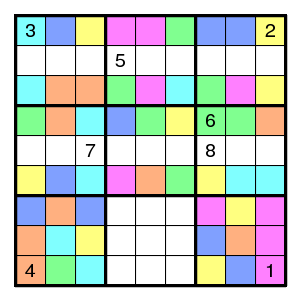
These 27 conditions are not independent: If 9 row conditions are satisfied, then the entire grid contains each digit 9 times. Now if also 8 column conditions are satisfied, then these columns together contain each digit 8 times, so that the last column automatically contains each digit once, and that last column does not add a restriction.
Similarly, given the row conditions for rows 1,2,3 and the box conditions for boxes 1 and 2, the box condition for box 3 is automatically satisfied. One sees that the boxes add only four independent restrictions.
Thus, the usual Sudoku setup has 9+8+4=21 restrictions.
The total number of filled Sudokus is 6670903752021072936960, and in order to arrive at a unique solution some clues (given digits) are needed. The puzzles with the smallest number of clues found so far have 17 clues.
The usual 27 restrictions are the 9 rows, the 9 columns, and the 9 boxes. Each must contain a permutation of the digits 1-9.
Here I coloured the cells with 9 colours and added the restriction that each colour sees a permutation of 1-9.
(There are 9+8+4+8=29 independent restrictions here.)
Puzzle: complete the below.

For example, here is one with eight colors - one restriction less.

And two with seven colors - again one less.


And three with six colors - again one less.



Variation: can one also choose the colour classes in a "nice" way?
The six colors above gave 5 restrictions. Here a version with 5 colors that give 5 restrictions (for a total of 9+8+4+5=26 restrictions).

I have not found an example with 4 colors yet.

For more puzzles of this type, see the Du-Sum-Oh page.
The examples with more than six colors here are best possible in this respect: 0 digits suffice. The examples with six colors (5 restrictions) use their digits. Of course, giving 9 different digits is equivalent to giving a color class, so six colors and 8 digits is almost the same as seven colors and 0 digits.
The Du-Sum-Oh puzzles of order N constructed on this page need 0 digits (with 3N-2 restrictions).
For the ordinary type of Sudoku, several examples are known with 16 givens among which only 7 distinct digits, with 2 completions. E.g. (example by Gordon Royle):
